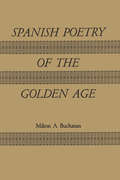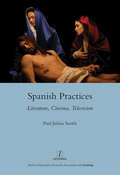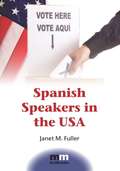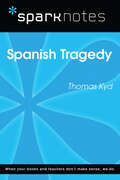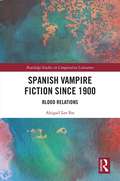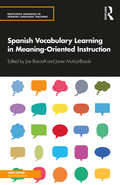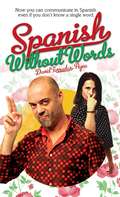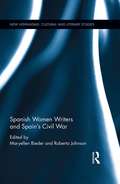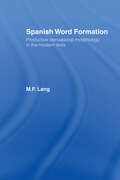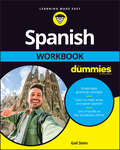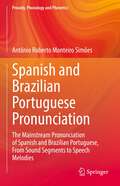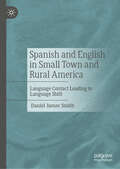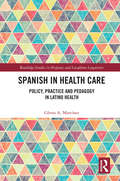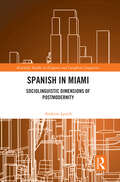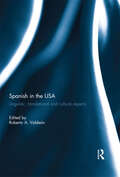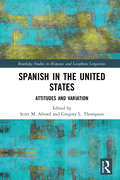- Table View
- List View
Spanish Poetry of the Golden Age (2nd Edition)
by Milton Alexander BuchananA representative selection of the best poetry of Spain's Golden Age.
Spanish Practices: Literature, Cinema, Television
by Paul Julian Smith"This book is the first to explore the interaction of three media in contemporary Spain. Focusing on some of the best known and most important books, feature films, and television series in the country (including novelist Antonio Munoz Molina, director Pedro Almodovar, and the Spanish version of telenovela Ugly Betty), it addresses three pairs of linked issues central to Hispanic studies and beyond: history and memory, authority and society, and genre and transitivity. Much of the material is very recent and thus as yet unstudied. The book also focuses on the representation of gender, sexuality, and transnationalism in these texts. Drawing on approaches from both the humanities and social sciences it combines close readings of key texts with the analysis of production processes, media institutions, audiences, and reception."
Spanish Romanticism and the Uses of History: Ideology and the Historical Imagination
by Derek FlitterFlitter examines those narratives within the intellectual parameters that defined them, probing the conceptual strategies by which writers represented history.
Spanish Speakers in the USA
by Janet M. FullerSpanish Speakers in the USA explores the relationship between language and culture both as specific to Latin@s and as a generalizable example of linguistic and cultural diversity. The concept of identity is explored, with special attention to culturally embedded ideas about 'race' and ethnicity, and how language contributes to identity construction. Also addressed are attitudes and beliefs about the Spanish language, and the people who speak it, as they are revealed in online communication, public discourse, films and television. Linguistic consequences of language contact are discussed, showing how so-called 'Spanglish' is both socially significant and linguistically mundane. The final chapter illuminates how the education of Spanish speakers in the USA school system is linked to issues surrounding Latin@ identities and ideologies about Spanish.
Spanish Tragedy (SparkNotes Literature Guide Series)
by SparkNotesSpanish Tragedy (SparkNotes Literature Guide) by Thomas Kyd Making the reading experience fun! Created by Harvard students for students everywhere, SparkNotes is a new breed of study guide: smarter, better, faster. Geared to what today's students need to know, SparkNotes provides: *Chapter-by-chapter analysis *Explanations of key themes, motifs, and symbols *A review quiz and essay topicsLively and accessible, these guides are perfect for late-night studying and writing papers
Spanish Vampire Fiction since 1900: Blood Relations (Routledge Studies in Comparative Literature)
by Abigail Lee SixSpanish Vampire Fiction since 1900: Blood Relations, as that subtitle suggests, makes the case for considering Spanish vampire fiction an index of the complex relationship between intercultural phenomena and the specifics of a time, place, and author. Supernatural beings that drink blood are found in folklore worldwide, Spain included, and writers ranging from the most canonical to the most marginal have written vampire stories, Spanish ones included too. When they do, they choose between various strategies of characterization or blend different ones together. How much will they draw on conventions of the transnational corpus? Are their vampires to be local or foreign; alluring or repulsive; pitiable or pure evil, for instance? Decisions like these determine the messages texts carry and, when made by Spanish authors, may reveal aspects of their culture with striking candidness, perhaps because the fantasy premise seems to give the false sense of security that this is harmless escapism and, since metaphorical meaning is implicit, it is open to argument and, if necessary, denial. Part I gives a chronological text-by-text appreciation of all the texts included in this volume, many of them little known even to Hispanists and few if any to non-Spanish Gothic scholars. It also provides a plot summary and brief background on the author of each. These entries are free-standing and designed to be consulted for reference or read together to give a sense of the evolution of the paradigm since 1900. Part II considers the corpus comparatively, first with regard to its relationship to folklore and religion and then contagion and transmission. Spanish Vampire Fiction since 1900: Blood Relations will be of interest to Anglophone Gothic scholars who want to develop their knowledge of the Spanish dimension of the mode and to Hispanists who want to look at some canonical texts and authors from a new perspective but also gain an awareness of some interesting and decidedly non-canonical material.
Spanish Vocabulary Learning in Meaning-Oriented Instruction (Routledge Advances in Spanish Language Teaching)
by Javier Muñoz-Basols Joe BarcroftSpanish Vocabulary Learning in Meaning-Oriented Instruction is the first comprehensive overview of current research and instructional practices into Spanish vocabulary acquisition through the lens of Meaning-Oriented Instruction (MOI). Key features: • a breadth of topics including language variation, input, tasks and processing specificity, incidental learning, idiomatic language, lexicographic perspectives, lexicosemantic representation, vocabulary testing, and receptive and productive vocabulary; • a combination of theory and practical guidance highlighting pedagogical best practices in the teaching of vocabulary; • guidance on the difficulties teachers face when teaching vocabulary in the classroom; • clear explanations with plenty of examples and useful references; • tasks and activities that help teachers move from a traditional curricular approach to a more innovative and engaging one focused on communicating, completing tasks, and learning content. Written by an international cohort of scholars in a succinct and accessible manner, Spanish Vocabulary Learning in Meaning-Oriented Instruction is an essential resource for teachers of Spanish at all levels. It is also an excellent reference book for researchers and both undergraduate and graduate students interested in Spanish vocabulary acquisition.
Spanish Without Words
by David Tarrada AgeaYou don't need words to speak Spanish. All you really need is this unique "phrase book" of the most common Spanish expressions, complete with authentic Spanish gestures and body language. It's the fastest and funniest way to learn Spanish ever published.You don't need words to speak Spanish. You don't have to study Spanish, or travel to Spain or Latin America to communicate in Spanish, either. All you really need is this unique "phrase book" of the most common Spanish expressions, complete with authentic Spanish gestures and body language. It's the fastest and funniest way to learn Spanish ever published. Now, even if you don't know a single word of Spanish, you can learn the most common greetings and expressions, dinner-table comments, hot vows of love, bargaining tricks, insults, threats and curses. This book shows you how. There's no faster or funnier way to learn how to communicate in Spain or Latin America, in Spanish, Mexican, Puerto Rican or Argentinian restaurants, with your grandparents or your friends.
Spanish Women Writers and Spain's Civil War (New Hispanisms: Cultural and Literary Studies)
by Roberta Johnson Maryellen BiederThe Spanish Civil War (1936-1939) pitted conservative forces including the army, the Church, the Falange (fascist party), landowners, and industrial capitalists against the Republic, installed in 1931 and supported by intellectuals, the petite bourgeoisie, many campesinos (farm laborers), and the urban proletariat. Provoking heated passions on both sides, the Civil War soon became an international phenomenon that inspired a number of literary works reflecting the impact of the war on foreign and national writers. While the literature of the period has been the subject of scholarship, women's literary production has not been studied as a body of work in the same way that literature by men has been, and its unique features have not been examined. Addressing this lacuna in literary studies, this volume provides fresh perspectives on well-known women writers, as well as less studied ones, whose works take the Spanish Civil War as a theme. The authors represented in this collection reflect a wide range of political positions. Writers such as Maria Zambrano, Mercè Rodoreda, and Josefina Aldecoa were clearly aligned with the Republic, whereas others, including Mercedes Salisachs and Liberata Masoliver, sympathized with the Nationalists. Most, however, are situated in a more ambiguous political space, although the ethics and character portraits that emerge in their works might suggest Republican sympathies. Taken together, the essays are an important contribution to scholarship on literature inspired by this pivotal point in Spanish history.
Spanish Word Formation
by M. F. LangFirst published in 1990. Routledge is an imprint of Taylor & Francis, an informa company.
Spanish Workbook For Dummies
by Gail Stein¿Habla español? Improve your Spanish with Dummies Spanish Workbook For Dummies is full of clear explanations and hundreds of practice activities for beginning Spanish learners. You'll learn how to express yourself, ask questions, talk about the past, and construct simple sentences—en español. As you work through the book, complete practice exercises, get lots of writing opportunities, and have tons of fun. Then check your work, with answers and explanations at the end of every chapter. Plus, you'll have access to handy verb charts, a thematic vocabulary list, and mini-dictionaries, right inside this very book. Learn the fundamentals of Spanish with integrated grammar that advances as you go Work through practice exercises and activities as you read through each chapter Improve and activate your Spanish with explanations of each workbook answer Avoid common mistakes made by Spanish learners and get ready to travel, chat with friends, or interact with colleagues This friendly Dummies workbook is perfect for beginners of all ages. If you're looking to get started with Spanish, step right in—we've got the practice, practice, practice you need to succeed.
Spanish and Brazilian Portuguese Pronunciation: The Mainstream Pronunciation of Spanish and Brazilian Portuguese, From Sound Segments to Speech Melodies (Prosody, Phonology and Phonetics)
by Antônio Roberto SimõesThis book contrasts variations in Spanish and Brazilian Portuguese pronunciation, using as a reference for discussion the mainstream careful speech of news anchors at the national level or the equivalent type of speech: a well-educated style that nonetheless sounds natural. Pursuing an innovative approach, the book uses this view of language as a cornerstone to describe and discuss other social and regional variants relative to that speaking register. It is aimed at speakers of Spanish interested in learning Portuguese and speakers of Portuguese who want to learn Spanish, as well as language specialists interested in bilingualism, heritage languages, in the teaching of typologically similar languages in contrast, and readers with interest in Phonetics and Phonology. The book employs a variety of innovative approaches, especially the reinterpretation of some of the traditional concept in Phonetics, and the use of speech prosodies and speech melodies, a user-friendly strategy to describe speech prosody in languages and speech melody in music through musical notation.
Spanish and English in Small Town and Rural America: Language Contact Leading to Language Shift
by Daniel James SmithThis book examines Spanish English bilingual patterns in a small town and rural Northeast Georgia community of Hispanics recently immigrated from Mexico and other areas of Latin America. Speech data from naturally-occurring conversations by 56 children and adults of both sexes are analyzed within Myers-Scotton’s Matrix Language Frame (MLF) model. Eight language patterns are identified, including monolingual Spanish and English turns, codeswitched turns, and turns showing convergence (morphemes/words from one language with grammatical structure from the other). Tokens of each type (per sentence or short conversational turn) were counted per informant. Analysis reveals that percentages of monolingual and codeswitched utterances pattern in relation to percentages of utterances showing convergence, indicating that informants’ Spanish does not begin to converge toward English until fewer than 70% of their utterances are monolingual Spanish and that both codeswitching and convergence are mechanisms of language shift from dominance in one language to another. Several associated social factors of the informants, including age, gender, and country of origin, expand understanding of the linguistic and shift patterns. The percentages of the different language types also indicate abrupt shifts from predominance of one language type to another. This 'snapshot' of a language shift in process and the abruptness of the shifts in stages is the unique observation of this study that has not been reported by other language contact researchers. The book also addresses the simultaneous acquisition of Spanish and English by young children and implications for education. The book will be of interest to students, teachers, and researchers of linguistics, sociolinguistics, bilingual education, and Spanish English contact specifically.
Spanish in Health Care: Policy, Practice and Pedagogy in Latino Health (Routledge Studies in Hispanic and Lusophone Linguistics)
by Glenn A. MartínezSpanish in Health Care fills an important gap by offering a panoramic overview of the research on Spanish in health settings that is emerging from a variety of disciplines. Synthesizing research from diverse disciplines such as sociolinguistics, discourse analysis, health services research, behavioral health research, health policy and administration, and social epidemiology, the volume offers a uniquely unified approach to the subject of Spanish in healthcare. This volume will be of interest to researchers in Spanish linguistics, sociolinguistics, health communication, and languages for specific purposes.
Spanish in Miami: Sociolinguistic Dimensions of Postmodernity (Routledge Studies in Hispanic and Lusophone Linguistics)
by Andrew LynchSpanish in Miami reveals the multifaceted ways in which the language is ideologically rescaled and sociolinguistically reconfigured in this global city. This book approaches Miami’s sociolinguistic situation from language ideological and critical cultural perspectives, combining extensive survey data with two decades of observations, interviews, and conversations with Spanish speakers from all sectors of the city. Tracing the advent of postmodernity in sociolinguistic terms, separate chapters analyze the changing ideological representation of Spanish in mass media during the late 20th century, its paradoxical (dis)continuity in the city’s social life, the political and economic dimensions of the Miami/Havana divide, the boundaries of language through the perceptual lens of Anglicisms, and the potential of South Florida—as part of the Caribbean—to inform our understanding of the highly complex present and future of Spanish in the United States. Spanish in Miami will be of interest to advanced students and researchers of Spanish, Sociolinguistics, and Latino Studies.
Spanish in the USA: Linguistic, translational and cultural aspects
by Roberto A. ValdeónDelving into the uneasy relationship between English and Spanish in the United States of America, this book approaches specific topics from a variety of perspectives, ranging from the more cultural to the more linguistic. The contributions explore the problems arising in Puerto Rico as a consequence of the unique political status of the island; the linguistic peculiarities of codeswitching, and its use in legal and medical contexts where interpreting is necessary and in educational contexts with heritage language students; the (non)use and the ideological implications of translation in colonial museums; the connections between language, ethnicity and gender identities in the South West; and the role played by the Hispanic press in promoting intercultural dialogue in the New York City area. Engaging with previous publications, the book examines these topics from an interdisciplinary standpoint, offers new insights into the problems of this cultural and linguistic contact, and suggests new areas of research. This book was originally published as a special issue of Language and Intercultural Communication.
Spanish in the United States: Attitudes and Variation (Routledge Studies in Hispanic and Lusophone Linguistics)
by Scott M. Alvord Gregory L. ThompsonSpanish in the United States: Attitudes and Variation is a collection of new, cutting-edge research with the purpose of providing scholars interested in Spanish as it is spoken by bilinguals living in the United States a current view of the state of the discipline. This volume is broad and inclusive of the populations studied, methodologies used, and approaches to the linguistic study of Spanish in order to provide scholars with an up-to-date understanding of the complexities of the Spanish(es) spoken in the United States. In addition to this snapshot, this volume stimulates new areas of inquiry and motivates new ways of analyzing the social, linguistic, and educational aspects of what it means to speak Spanish in the United States.
Spanish-English Picture Dictionary (First Bilingual Picture Dictionaries)
by Louise Millar Susan Martineau Catherine BruzzoneAre there kids in your life who want to learn Spanish? This is the perfect dictionary! Included are pages filled with bright and colorful pictures and bilingual labels to help teach Spanish words to English speaking children.Parents, teachers, and gift givers will find:350 illustrations of familiar objectsPictures labeled with the English word followed by its Spanish equivalentPhonetic spellings of Spanish wordsWords grouped by themesThis dictionary is a fun way for young English-speaking children to build a basic vocabulary in Spanish. It's never too soon to start teaching boys and girls a second language!
Spanish-Language Pragmatics: A Guide for Teachers (Routledge Advances in Spanish Language Teaching)
by Rachel L. ShivelySpanish-Language Pragmatics: A Guide for Teachers provides Spanish instructors with a user-friendly introductory guide to teaching Spanish pragmatics and is designed to make it easier to implement pragmatics instruction in the classroom.The book begins by discussing both the what and how, introducing the field of pragmatics and providing descriptions of various features of Spanish pragmatics that can be targeted in teaching. Instructors are presented with an approach to incorporating pragmatics into the language curriculum with specific teaching techniques and materials laid out. Spanish-Language Pragmatics is grounded in research and theory which is applied to the practice of teaching Spanish pragmatics in the classroom setting.Both pre-service and in-service Spanish language instructors in secondary, tertiary, and community contexts who are interested in teaching pragmatics will find this book to be an invaluable resource. Additional downloadable materials, which include discussion and analysis questions for each chapter, instructional units and sample lesson plans, and ideas for learning objectives and assessments, are available at www.routledge.com/9781138695528.
Spanish/English Business Correspondence: Correspondecia de comercio Espanol/Ingles
by Michael Gorman Maria-Luisa HensonFirst published in 1997. Routledge is an imprint of Taylor & Francis, an informa company.
Spanish/English Business Glossary
by Michael Gorman Maria-Luisa HensonThis is the essential reference companion for all who use Spanish for business communication.Containing over 5000 words, this handy two-way A-Z glossary covers the most commonly used terms in business. It will help you to communicate with confidence in a wide variety of business situations, and is of equal value to the relative beginner or the fluent speaker.Written by an experienced native and non-speaker team working in business language education, this unique glossary is an indispensable reference guide for all students and professionals studying or working in business where Spanish is used.
Spanish: An Essential Grammar (Routledge Essential Grammars)
by Ian Mackenzie Peter T BradleySpanish: An Essential Grammar is a concise and user-friendly reference guide to the most important aspects of Spanish.It presents a fresh and accessible description of the language that combines traditional and function-based grammar. The book sets out the complexities of Spanish in short, readable sections, and explanations are clear and free from jargon.The Grammar is the ideal reference source for the learner and user of Spanish. It is suitable for either independent study or for students in schools, colleges, universities and adult classes of all types. Features include:* clear distinctions between the essential and basic aspects of Spanish grammar and those that are more complex* full use of authentic examples* easy to understand explanations of areas that customarily pose problems for English speakers* detailed contents list and index for easy access to information.
Sparing the Child: Grief and the Unspeakable in Youth Literature about Nazism and the Holocaust (Children's Literature and Culture #Vol. 16)
by Hamida BosmajianBosmajian explores children's texts that have either a Holocaust survivor or a former member of the Hitler Youth as a protagonist.
Sparking Creativity in the World Language Classroom: Strategies and Ideas to Build Your Students’ Language Skills
by Deborah Blaz Tom AlsopJam-packed with inspiring lessons and ideas, this book will help you access and enhance your own creativity in the classroom and inspire your students to become motivated language learners. Top authors Blaz and Alsop share practical strategies to channel your creative impulses and transform them into effective lessons that will energize students of all levels. Aligned with ACTFL (American Council on the Teaching of Foreign Languages) and CEFR (Common European Framework of Reference for Languages) standards, the resources in this book support creativity as a practical process, with step-by-step guidance on goal-setting, implementation, evaluation, and feedback. Examples come from many world languages and cover fun and original topics, including tapping into students’ own interests through cooking, memes, online videos, sports, arts and crafts, and more. Relevant for all levels of language instruction, this text includes plentiful photocopiable charts, templates, and samples to use in the classroom.
Spatial Engagement with Poetry
by Heather H. YeungDrawing from a broad range of contemporary British poets, including Thomas Kinsella, Kathleen Jamie, and Alice Oswald, this study examines the inherently spatial and affective nature of our engagement with poetry. Adding to the expanding field of geocritical studies, Yeung specifically discusses ideas of space and constructions of voice in poetry.
